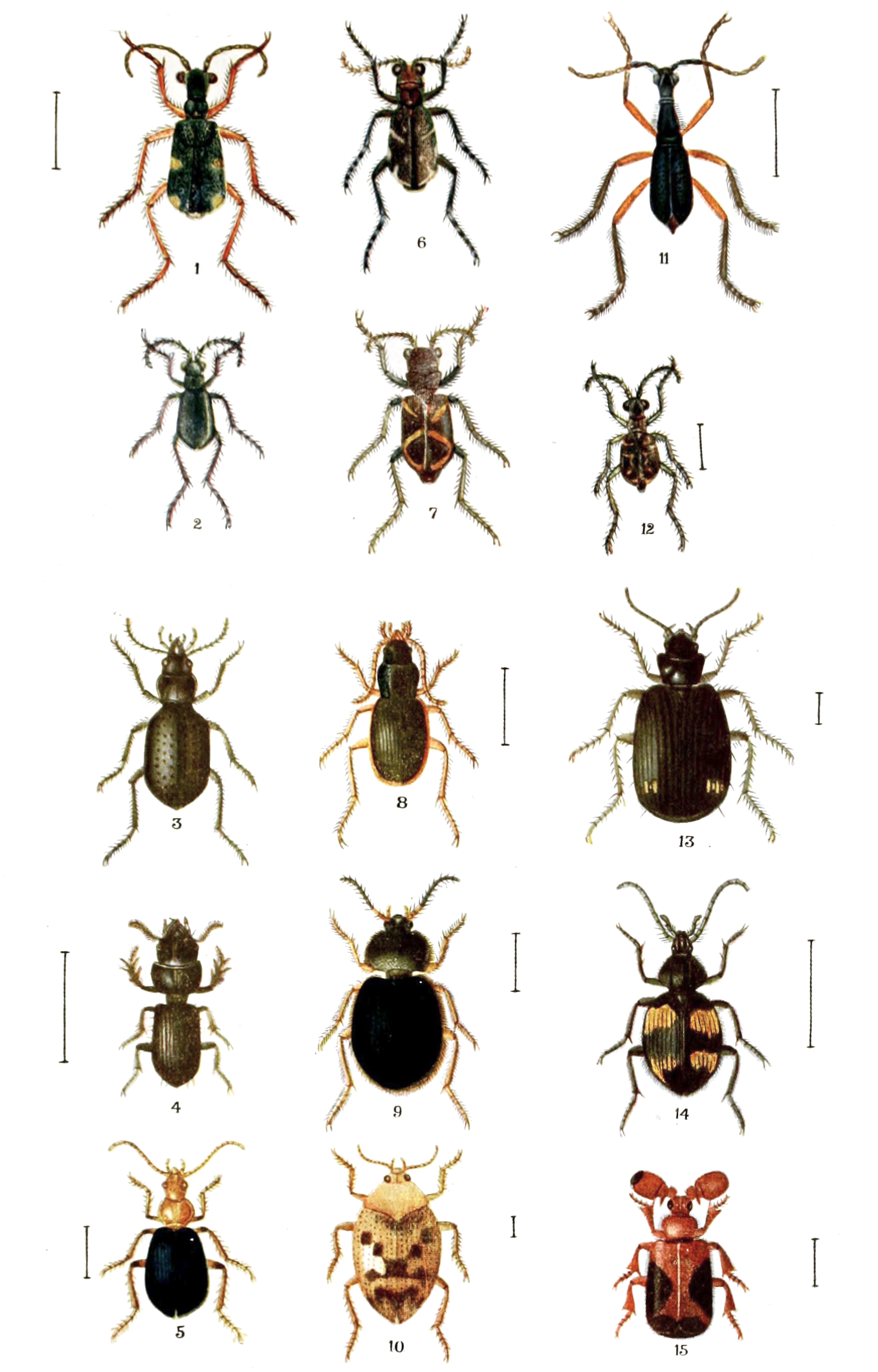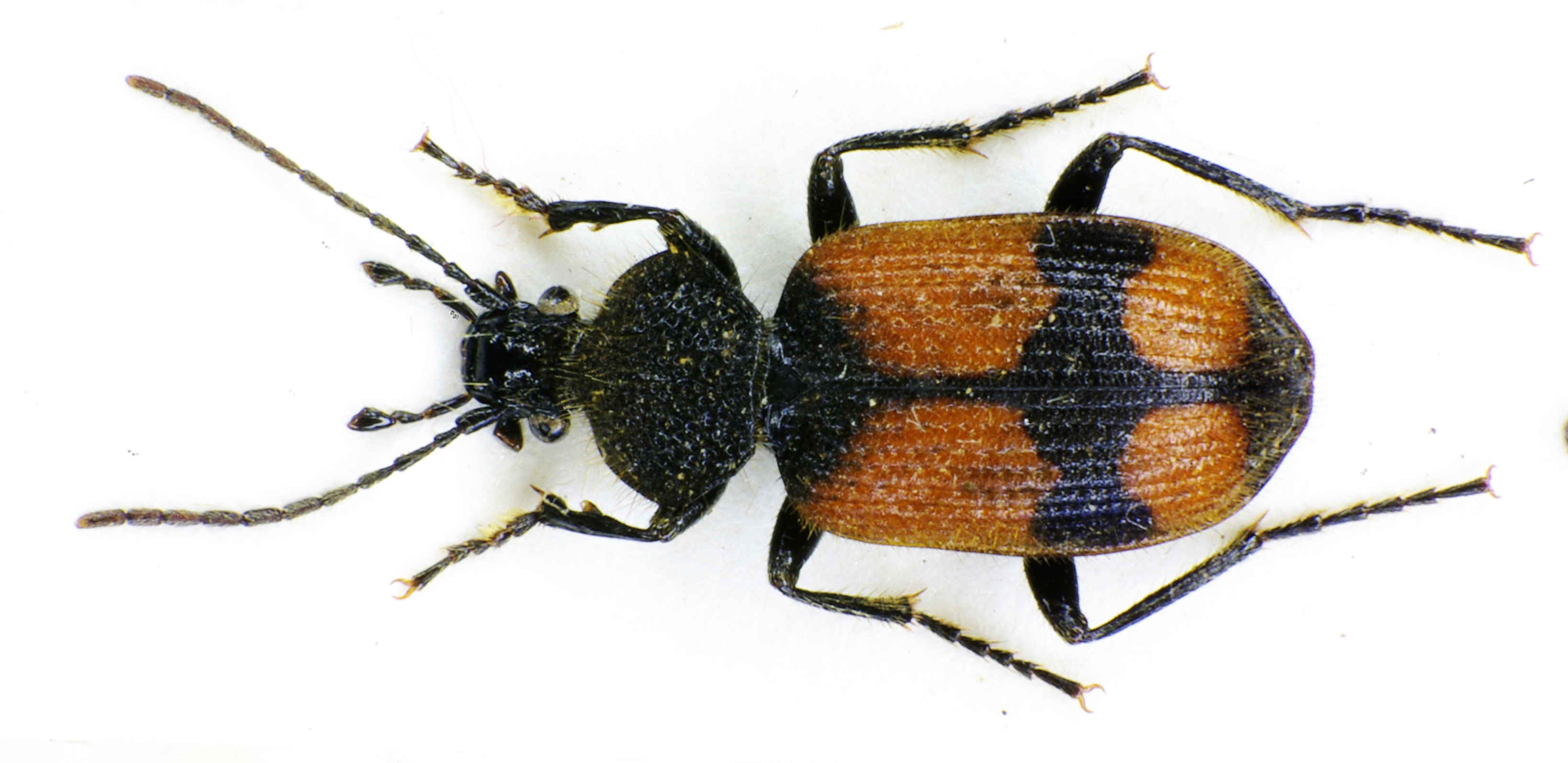|
Adephaga Genera
The Adephaga (from Greek ἀδηφάγος, ''adephagos'', "gluttonous") are a suborder of beetles, and with more than 40,000 recorded species in 10 families, the second-largest of the four beetle suborders. Members of this suborder are collectively known as adephagans. The largest family is Carabidae (ground beetles) which comprises most of the suborder with over 40,000 species. Adephaga also includes a variety of aquatic beetles, such as predaceous diving beetles and whirligig beetles. Anatomy Adephagans have simple antennae with no pectination or clubs. The galeae of the maxillae usually consist of two segments. Adult adephagans have visible notopleural sutures. The first visible abdominal sternum is completely separated by the hind coxae, which is one of the most easily recognizable traits of adephagans. Five segments are on each foot. Wings The transverse fold of the hind wing is near the wing tip. The median nervure ends at this fold, where it is joined by a cros ... [...More Info...] [...Related Items...] OR: [Wikipedia] [Google] [Baidu] |
Cybister
''Cybister'' ('kybistētēr' = diver, tumbler), is a genus of beetle in family Dytiscidae. They are found in much of the world, including all continents except Antarctica. As of 2024 there are 98 species and 9 additional subspecies among four subgenera in the genus. Description Adult ''Cybister'' have broad hind legs with unequal tarsal claws (the inner claw being smaller and sometimes absent) and a fringe on the outer margin of the tarsus. They range in length up to 43 mm ('' C. bimaculatus'' from the Afrotropics). Adult males of the North American species have several ridges on the coxae of the hind legs, forming a stridulatory device. Larvae have a frontal tooth on the head and lack cerci. North American species can grow up to 80 mm long. Ecology ''Cybister'' live in lentic (still fresh water) habitats that have vegetation. Like other diving beetles, ''Cybister'' are predatory. Larvae of '' C. japonicus'' prey on insects (mainly Odonata nymphs and the backswimmer ''No ... [...More Info...] [...Related Items...] OR: [Wikipedia] [Google] [Baidu] |
Meruidae
Meruidae is a family of aquatic beetles in the suborder Adephaga, with only one genus and species, ''Meru phyllisae''. The beetle species was first found in the early 1980s.Paul J. Spangler, Warren E. Steiner JR (2005) A new aquatic beetle family, Meruidae, from Venezuela (Coleoptera: Adephaga) Systematic Entomology 30 (3), 339–357 and fully described in 2005. At , it is one of the smallest adephagan beetles in the world. A survey of aquatic beetles of Venezuela indicated that ''Meru'' is most common during the wet season, when larger areas of granitic rock surface are covered with water film, which the adult beetles as well as the larvae inhabit. Etymology The name Meruidae comes from the local Pemon people word for waterfall, ''meru''. The beetle was given this name because it can only be found in cascading water. Distribution ''Meru phyllisae'' is only known from the natural cascading waterfalls in El Tobogán, Las Amazonas, Venezuela Venezuela, officially the Boli ... [...More Info...] [...Related Items...] OR: [Wikipedia] [Google] [Baidu] |
Antenna (biology)
An antenna (plural: antennae) is one of a pair of appendages used for Sensory system, sensing in arthropods. Antennae are sometimes referred to as ''feelers''. Antennae are connected to the first one or two Segmentation (biology), segments of the arthropod head. They vary widely in form but are always made of one or more jointed segments. While they are typically sensory organs, the exact nature of what they sense and how they sense it is not the same in all groups. Functions may variously include sensing tactition, touch, air motion, heat, vibration (sound), and especially insect olfaction, smell or gustation, taste. Antennae are sometimes modified for other purposes, such as mating, brooding, swimming, and even anchoring the arthropod to a substrate (biology), substrate. Larval arthropods have antennae that differ from those of the adult. Many crustaceans, for example, have free-swimming larvae that use their antennae for swimming. Antennae can also locate other group members i ... [...More Info...] [...Related Items...] OR: [Wikipedia] [Google] [Baidu] |
Whirligig Beetle
The whirligig beetles are water beetles, comprising the family Gyrinidae, that usually swim on the surface of the water if undisturbed, though they swim underwater when threatened. They get their common name from their habit of swimming rapidly in circles when alarmed, and are also notable for their divided eyes which are believed to enable them to see both above and below water. (View wiki description) The family includes some 700 extant species worldwide, in 15 genera, plus a few fossil species. Most species are very similar in general appearance, though they vary in size from perhaps 3 mm to 18 mm in length. They tend to be flattened and rounded in cross section, in plain view as seen from above, and in longitudinal section. In fact their shape is a good first approximation to an ellipsoid, with legs and other appendages fitting closely into a streamlined surface. Whirligig beetles belong to the beetle suborder Adephaga, which also includes ground beetles and divin ... [...More Info...] [...Related Items...] OR: [Wikipedia] [Google] [Baidu] |
Predaceous Diving Beetle
The Dytiscidae, from the Ancient Greek word δυτικός (''dystikos''), meaning "able to dive", are the predaceous diving beetles, a family of water beetles. They occur in virtually any freshwater habitat around the world, but a few species live in terrestrial habitats such as among leaf litter. The “diving” in their common name comes from their cycling between underwater and the surface to replenish oxygen like a diver. The adults of most are between long, though much variation is seen between species. The European ''Dytiscus latissimus'' and Brazilian '' Bifurcitus ducalis'' are the largest, reaching up to respectively, although the latter is listed as extinct by the IUCN. In contrast, the smallest is likely the Australian '' Limbodessus atypicali'' of subterranean waters, which only is about long. Most are dark brown, blackish, or dark olive in color with golden highlights in some subfamilies. The larvae are commonly known as water tigers due to their voracious appetit ... [...More Info...] [...Related Items...] OR: [Wikipedia] [Google] [Baidu] |
Ground Beetle
Ground beetles are a large, cosmopolitan distribution, cosmopolitan family (biology), family of beetles, the Carabidae, with more than 40,000 species worldwide, around 2,000 of which are found in North America and 2,700 in Europe. As of 2015, it is one of the 10 most species-rich animal families. They belong to the Adephaga. Members of the family are primarily Carnivore, carnivorous, but some members are Herbivore, herbivorous or Omnivore, omnivorous. Description and ecology Although their body shapes and coloring vary somewhat, most are shiny black or metallic and have ridged wing covers (elytra). The elytra are fused in some species, particularly the large Carabinae, rendering the beetles unable to fly. The species ''Mormolyce phyllodes'' is known as violin beetle due to their peculiarly shaped elytra. All carabids except the quite primitive flanged bombardier beetles (Paussinae) have a groove on their arthropod leg, fore leg tibiae bearing a comb of hairs used for cleaning the ... [...More Info...] [...Related Items...] OR: [Wikipedia] [Google] [Baidu] |
Beetles
Beetles are insects that form the Taxonomic rank, order Coleoptera (), in the superorder Holometabola. Their front pair of wings are hardened into wing-cases, elytra, distinguishing them from most other insects. The Coleoptera, with about 400,000 described species, is the largest of all orders, constituting almost 40% of described arthropods and 25% of all known animal species; new species are discovered frequently, with estimates suggesting that there are between 0.9 and 2.1 million total species. However, the number of beetle species is challenged by the number of species in Fly, dipterans (flies) and hymenopterans (wasps). Found in almost every habitat except the sea and the polar regions, they interact with their ecosystems in several ways: beetles often feed on plants and fungi, break down animal and plant debris, and eat other invertebrates. Some species are serious agricultural pests, such as the Colorado potato beetle, while others such as Coccinellidae (ladybirds or ... [...More Info...] [...Related Items...] OR: [Wikipedia] [Google] [Baidu] |
Greek Language
Greek (, ; , ) is an Indo-European languages, Indo-European language, constituting an independent Hellenic languages, Hellenic branch within the Indo-European language family. It is native to Greece, Cyprus, Italy (in Calabria and Salento), southern Albania, and other regions of the Balkans, Caucasus, the Black Sea coast, Asia Minor, and the Eastern Mediterranean. It has the list of languages by first written accounts, longest documented history of any Indo-European language, spanning at least 3,400 years of written records. Its writing system is the Greek alphabet, which has been used for approximately 2,800 years; previously, Greek was recorded in writing systems such as Linear B and the Cypriot syllabary. The Greek language holds a very important place in the history of the Western world. Beginning with the epics of Homer, ancient Greek literature includes many works of lasting importance in the European canon. Greek is also the language in which many of the foundational texts ... [...More Info...] [...Related Items...] OR: [Wikipedia] [Google] [Baidu] |
Colymbothetidae
Colymbothetidae is an extinct family of beetles in the suborder Adephaga. '' Colymbothethis'' is known from larvae from the Upper Triassic of Kazakhstan. They probably belong to the Dytiscoidea. References Prehistoric insect families † A dagger, obelisk, or obelus is a typographical mark that usually indicates a footnote if an asterisk has already been used. The symbol is also used to indicate death (of people) or extinction (of species or languages). It is one of the mo ... Adephaga {{Adephaga-stub ru:Parahygrobiidae ... [...More Info...] [...Related Items...] OR: [Wikipedia] [Google] [Baidu] |
Liadytidae
Liadytidae is an extinct family of adephagan beetles. There are at least two genera and about seven described species in Liadytidae. They are known from the Early Jurassic to Early Cretaceous of Asia. They are members of the clade Dytiscoidea, and like other members of that group were adapted for aquatic life. Genera These two genera belong to the family Liadytidae: * † '' Liadytes'' Ponomarenko, 1963 * † '' Ovidytes'' Ren, Zhu & Lu, 1995 References Adephaga † A dagger, obelisk, or obelus is a typographical mark that usually indicates a footnote if an asterisk has already been used. The symbol is also used to indicate death (of people) or extinction (of species or languages). It is one of the mo ... Prehistoric insect families {{Adephaga-stub ... [...More Info...] [...Related Items...] OR: [Wikipedia] [Google] [Baidu] |





